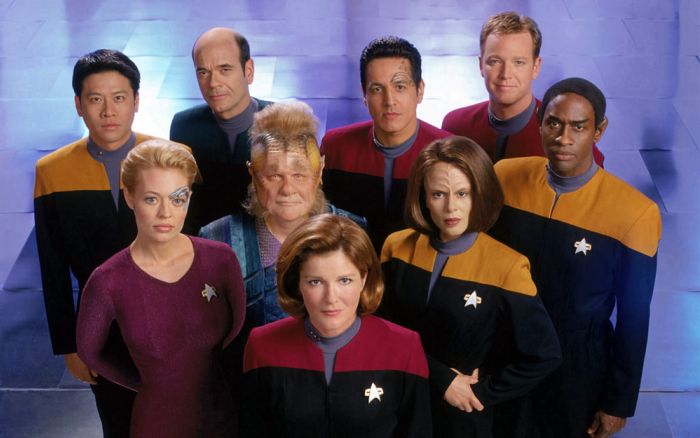Celebrating the “anti-action, existential feminist family drama” of Star Trek: Voyager

Ian Grey has recently posted a celebration of Star Trek: Voyager, or as he calls it, “at once the most Star Trek-ian of accomplishments and the most despised object of fanboy loathing in the franchise’s nearly 50-year history.”
But why so much “fanboy loathing”? For starters, Voyager undermined the Star Trek franchise’s established order when it came to gender and ethnicity:
Show creators Rick Berman, Michael Piller and Jeri Taylor clearly asked themselves the same thing. They breathed new life into a moribund franchise by taking the whole “where no man has gone before” thing and really running with it. As the critic Alan Sepinwall reminds us, a great show teaches us how to watch it. With Voyager, the fanboys would have to learn how to live without a default male lead to identify with, a hero in Kirk/Picard/Riker mode. They would have to learn to identify beyond gender, and the challenge didn’t end at the captain’s chair. Along with Mulgrew’s fascinating, maddening Captain Janeway — bullheaded; childless by choice; at once doctrinaire and impulsive — the showrunners gave us a prickly/brilliant Chief Engineer named B’Elanna Torres (Roxann Dawson) struggling with her biracial half-human Hispanic, half-Klingon identity. By season four, ship botanist Kes (Jennifer Lien) left Voyager; her screentime was filled with a 103-episode-long redemption tale about a bemused, tragic and insanely svelte de-assimilated Borg called Seven of Nine (Jeri Ryan).
The show also expected viewers to spend time with an Asian Operations Officer (Garrett Wang), a half-black, half-Vulcan tactical officer (Tim Russ), and a Native American First Officer (Robert Beltran) before finally meeting the crew’s significant male Caucasians, none of whom fit the traditional Buck Rogers/Flash Gordon/Luke Skywalker/James Kirk descriptors. One was the hilariously arch medical hologram played by Robert Picardo. The other was helmsman Tom Paris (Robert Duncan McNeill).
Also, the show changed the posture of our protagonists. Whereas previous Star Trek series featured bold explorers charting the unknown and defending the Federation, Voyager adopted a more defensive, passive, and melancholy posture:
This series wasn’t built around officers that could project military force, which is itself essentially masculine, whenever they needed to, and expect to be backed by the full faith and credit of Starfleet, even when they’d done something wrong or stupid. They were isolated, deprived of the usual political-military support network that made all other Trek adventures, including Deep Space Nine, so comforting to fans.
The story began when the USS Voyager was hurled by an energy wave 70,000 light-years, to the butt end of the universe. After that, her mission was simplified: aim Earthwards for a 75-year journey home that the crew was unlikely to survive.
And that was it. No Starfleet hijinks, no strutting around the galaxy, just 150 or so people stuck together for life. Voyager often feels less like a continuation of Trek as we know it than a challenge in the form of a question: “So you think you know what Star Trek is?” The series is an anti-action, existential feminist family drama, shot through with a persistent melancholy that reflects the crew’s desperation.
Yes, it’s still Star Trek, but the sheer unfamiliarity of the crew’s predicament was disorienting. This far end of space is haunted by the violence of war. Mass violence carries more weight here, arguably, than in any other incarnation of Star Trek, and it’s no stretch to suggest that the show’s tragic attitude toward war comes out of its female-centered perspective.
I’ll admit, I never watched much of Voyager beyond the third season, aside from an episode here or there on Netflix. I was much less enthusiastic about Voyager than I was The Next Generation. Which might just prove Grey’s point. (But for what it’s worth, I was also pretty lukewarm when it came to Deep Space Nine.)
My favorite part of Grey’s piece comes at the end, when he compares Voyager’s female characters to the female characters in today’s television landscape, and finds the modern characters lacking.
[T]he self-determined female leads of Voyager — and Buffy, and a handful of other unusual genre series — have been supplanted by strong female characters that aren’t really as strong as they seem. As former Salon TV critic Heather Havrilesky noted in her New York Times piece, “TV’s New Wave of Women: Smart, Strong, Borderline Insane,” even our richest female leads come with a soupçon of instability. “I don’t mean complicated, difficult, thorny or complex,” she writes. “I mean that these women are portrayed as volcanoes that could blow at any minute. Worse, the very abilities and skills that make them singular and interesting come coupled with some hideous psychic deficiency.”
All in all, some pretty thought-provoking stuff, especially if you’re even the slightest bit a Trekkie. I love this type of critical evaluation of nerdy material. (And surprise, there’s even some good discussion in the comments.) I suddenly feel the urge to have a Star Trek: Voyager marathon soon.